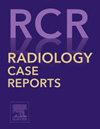Chronic headache and obstructive hydrocephalus: A case of pilocytic astrocytoma in the third ventricle with detailed radiological and histopathological findings
Q4 Medicine
引用次数: 0
Abstract
Pilocytic astrocytoma is a benign, slow-growing tumor classified as a WHO Grade I glioma, commonly affecting children and young adults. This case highlights the clinical, radiological, and histopathological features of a third-ventricle pilocytic astrocytoma and its management through endoscopic resection. An 18-year-old female presented with a one-year history of generalized headache, aggravated over the past month. Magnetic resonance imaging (MRI) revealed a mass lesion in the third ventricle, characterized by hypointensity on T1, hyperintensity on T2/FLAIR, no restriction on DWI, high signal intensity on ADC, and intense postcontrast enhancement. The lesion caused obstructive hydrocephalus in the bilateral lateral ventricles. The patient underwent successful endoscopic resection of the tumor. Histopathological examination confirmed pilocytic astrocytoma, showing biphasic patterns, Rosenthal fibers, and eosinophilic granular bodies. This case underscores the importance of multimodal diagnostic approaches and timely surgical intervention in managing pilocytic astrocytoma. Radiological imaging plays a pivotal role in preoperative planning, while histopathology confirms the diagnosis and guides further treatment.
求助全文
约1分钟内获得全文
求助全文
来源期刊

Radiology Case Reports
Medicine-Radiology, Nuclear Medicine and Imaging
CiteScore
1.10
自引率
0.00%
发文量
1074
审稿时长
30 days
期刊介绍:
The content of this journal is exclusively case reports that feature diagnostic imaging. Categories in which case reports can be placed include the musculoskeletal system, spine, central nervous system, head and neck, cardiovascular, chest, gastrointestinal, genitourinary, multisystem, pediatric, emergency, women''s imaging, oncologic, normal variants, medical devices, foreign bodies, interventional radiology, nuclear medicine, molecular imaging, ultrasonography, imaging artifacts, forensic, anthropological, and medical-legal. Articles must be well-documented and include a review of the appropriate literature.
 求助内容:
求助内容: 应助结果提醒方式:
应助结果提醒方式:


